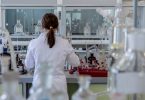Chemical Comparison
Introducing from the green corner — weighing in at 511,442 acres, a plant that boasts federal legality and stands as the world heavyweight cannabidiol (CBD) champion… HEMP!
And now from the other green corner — weighing in at over $12 billion in retail sales, a plant claiming legality in 33 states and enjoying the title of world heavyweight Δ-9-tetrahydrocannabinol (THC) champion… CANNABIS!
Ready to explore the differences between hemp and cannabis? Let’s get ready to rumble.
Conventional attitudes portray hemp as the innocuous, industrial “cousin” of psychoactive cannabis, the latter branded a problem child that inspires fear and loathing. But in truth, industrial hemp and psychoactive cannabis are the same plant species — Cannabis sativa L.
There’s no taxonomic difference between psychoactive cannabis and hemp. The difference is inter-species chemical variation. Human beings have created these variant “subspecies” by cultivating the plant for divergent purposes. [1,2]
Hemp is defined by legislation. Per the United States Department of Agriculture, “The tetrahydrocannabinol (THC) concentration is the distinguishing factor between industrial hemp and [cannabis].” As of 2018 in the United States, hemp corresponds to THC levels below 0.3%. The European Union, on the other hand, draws the line at 0.2% THC.
This fine line is a significant challenge for hemp cultivators. This year, regulators forced the destruction of more than half of Hawaii’s hemp crops as they exceeded legal THC limits. The blame likely falls on Hawaii’s unique climate and photoperiod. Indeed, environmental conditions can easily push low-THC genetics above the 0.3% threshold. According to Dr. George Place of North Carolina State University, “Growers need to be aware that plant stresses (drought, flooding, excessive nutrients, not enough nutrients, heat, cold, etc.) can result in THC spikes.” In other words, “hemp” can become “cannabis” overnight.
Of course, plant genetics matter. A study in Genetics examined the alleles of three cannabis chemotypes: those with high THC–low CBD (i.e., psychoactive cannabis), those with mixed THC–CBD, and those with low THC–high CBD (i.e., hemp). [3] Alleles determine the variation of genes. They generally come in pairs: a “dominant” allele and a “recessive “allele, two dominants, or two recessives.
These researchers analyzed hundreds of plants and isolated a locus (physical location of a gene sequence) that they referred to as B. At the B locus, hemp samples had a combination of BD/BD alleles. Psychoactive cannabis samples had a combination of BT/BT alleles. Hybrid plants (mixed CBD/THC) had codominant alleles, BT/BD. The researchers hypothesized that these alleles code for enzyme isoforms that direct cannabinoid synthesis, where BT codes for the enzyme isoform (THCa synthase) that promotes the synthesis of tetrahydrocannabinolic acid (THCa), and BD codes for the enzyme isoform (CBDa synthase) that helps synthesize cannabidiolic acid (CBDa). [3] The key takeaway is that genetic variation determines the overall macro ratio of THC:CBD in a given plant.
A more recent study published in PLoS ONE examined the genetic structure of 81 psychoactive cannabis samples and 43 hemp samples. Researchers proposed that the “distinction between these populations is not limited to genes underlying THC production.” [4]
In psychoactive cannabis, cannabinoid pathway genetics were more expressed compared to hemp, suggesting that psychoactive cannabis is generally more adept at producing cannabinoids. Researchers also discovered that cannabis tends toward in-breeding, but hemp comes from a larger genetic pool. [4] Both findings make sense; for decades, cannabis cultivators have interbred plants in order to maximize cannabinoid production. Hemp, on the other hand, was traditionally bred for fiber, oil, and food. [5]
Through breeding and cultivation, humans effectively orchestrate genotype, phenotype, and the entire phytochemical profile of Cannabis sativa L. What is the chemical difference between hemp and cannabis? Cannabis packs a powerful THC uppercut, while hemp delivers a devastating CBD hook. It’s a unanimous draw. Or depending on preference, a split decision.
References
- Pollio, Antonino. “The Name of Cannabis: A Short Guide for Nonbotanists.” Cannabis and Cannabinoid Research, vol. 1, no. 1, 2016, pp. 234–238, doi:10.1089/can.2016.0027. Times Cited = 5 (ResearchGate)
- Small, Ernest. “Classification of Cannabis Sativa L. in Relation to Agricultural, Biotechnological, Medical and Recreational Utilization.” Cannabis Sativa L. – Botany and Biotechnology, edited by S. Chandra, H. Lata, and M. ElSohly. Springer, 2017, pp. 1–62, doi:10.1007/978-3-319-54564-6_1.
- De Meijer, E.P.M., et al. “The Inheritance of Chemical Phenotype in Cannabis sativa L.”Genetics, vol. 163, no. 1, 2003, pp. 335-346. Journal Impact Factor = 4.075, Times Cited = 153 (ResearchGate)
- Sawler, Jason, et al. “The Genetic Structure of Marijuana and Hemp.” PLOS One, vol. 10, no. 8, 2015, doi:10.1371/journal.pone.0133292. Journal Impact Factor = 2.776, Times Cited = 78 (ResearchGate)
- Bakel, Harm Van, et al. “The Draft Genome and Transcriptome of Cannabis Sativa.” Genome Biology, vol. 12, no. 10, 2011, doi:10.1186/gb-2011-12-10-r102. Journal Impact Factor = 13.214, Times Cited = 248 (ResearchGate)








